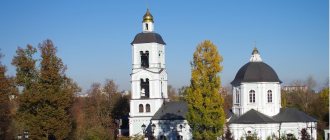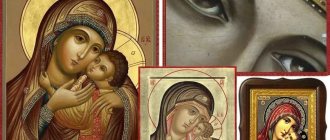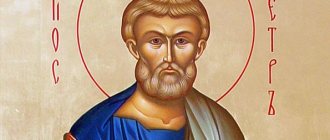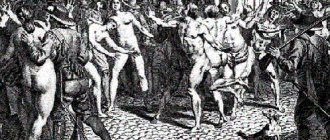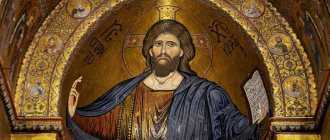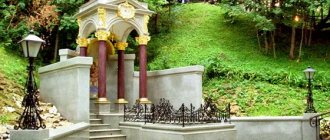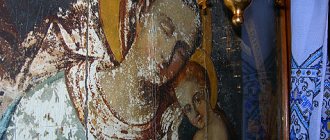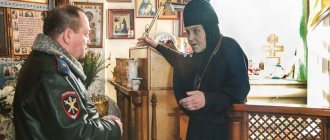"Save me, God!".
Thank you for visiting our website, before you start studying the information, please subscribe to our Orthodox community on Instagram, Lord, Save and Preserve † - https://www.instagram.com/spasi.gospodi/. The community has more than 60,000 subscribers. There are many of us like-minded people and we are growing quickly, we post prayers, sayings of saints, prayer requests, and timely post useful information about holidays and Orthodox events... Subscribe. Guardian Angel to you!
The icon of the Life-Giving Source of the Mother of God dates back to the 5th century. It was then that, near Constantinople, a miraculous image with the help of a source was able to heal a blind man. This miracle could not go unnoticed, and after that, everyone knew about this diva by decree of Emperor Leo I, in honor of the miracle created, a temple was built not far from the divine source.
It is very difficult to name even an approximate number of people who were able to heal themselves in this temple. And soon lists began to be written from the image of a source standing nearby, which were then distributed throughout the world, giving Orthodox people healing and God’s grace.
The shrine itself depicts the Mother of God sitting in a font with little Jesus in her arms. From such a type as Nikopeia Kyriotissa (Lady Victorious) comes the iconography of this face of the Mother of God. From the very beginning, the source was not painted on the shrine, but later the Vial (bowl) was also included in the overall composition. And later they began to depict a pond and a fountain on the shrine.
- Prayer to the Life-Giving Source
History of the holy image
In the middle of the 5th century in Constantinople, near the gate, which was called “Golden”, there was a grove. This grove was dedicated to the Most Pure One. There was a spring in the grove that became widely known because of the miracles that happened there. Over time, the grove became densely overgrown with bushes, and the water was covered with mud.
The Emperor of Byzantium, Leo Markel, was a warrior before his accession to the throne. One day he was passing near that place and he met a blind wanderer who had lost his way and could not find his way. The warrior helped his neighbor, led him onto the path and placed him in a shady place so that the wanderer could rest. Leo himself went to look for water to give the blind man something to drink.
Suddenly he heard someone speaking to him, but saw no one. The voice told him not to look far for water, as it was nearby. Leo was surprised and began to look for the source, but did not find it. The warrior stopped and thought. Then the voice addressed him again, this time as King Leo, and told him to take water under the shade of the grove. The traveler must be given water to drink, and the mud must be placed on his unseeing eyes. The voice continued: “Then you will know who I am, who sanctifies this place.” Leo received a promise to help erect a temple on this site and heal everyone who came to this place with prayer. After fulfilling what was said, the blind wanderer regained his sight and was able to go to the city on his own, praising the Most Holy Theotokos.
Icon of the Mother of God “Life-Giving Spring”
Over time, Leo Markel ascended the throne of the emperor. He remembered what the Queen of Heaven told him. By his order, the wonderful spring was cleaned out and taken into a stone circle. A temple was erected above it in honor of the Blessed Virgin Mary. The emperor himself gave the name to the spring “Life-Giving Spring”, because the miraculous grace of the Most Pure One was manifested on its waters. The icon “Life-Giving (Life-Giving) Source” was placed in the temple.
Time passed. Emperor Justinian the Great was a very religious man. He suffered from water sickness. One day at midnight a voice said to him: “You cannot be healed unless you drink from My fountain.” But the ruler did not know which source was meant, and became despondent. Then, already in the daytime, the Most Pure One appeared to him again and told him to go to Her source and drink from it. Only then will he be healed. The Emperor acted according to the word of the Queen of Heaven, and soon his health returned to him. Then he built a new church near the temple built under King Leo. Later, a monastery appeared near it.
A thousand years after these events, the temple of the “Life-Giving Spring” was destroyed by Muslims. A warrior was stationed near the ruins to prevent Christians from approaching the rubble. Over time, the strict ban was relaxed, and the Orthodox were able to build a small temple there. But in 1821 it was also destroyed, and the wonderful spring was filled up. The Christians set to work again: they cleared the ruins, restored the source and continued to draw water from it. Later, in one of the windows of the ruins remaining from the temple, a sheet was discovered on which ten miracles that occurred at this place from 1824 to 1829 were indicated.
The day of celebration falls on April 4th
During the reign of Sultan Mahmud, the Orthodox were given a number of freedoms, and people built a temple over this amazing spring. It was consecrated by Patriarch Constantine with the concelebration of 20 bishops and a large crowd of worshipers. Then an almshouse and a hospital were set up at the temple.
One more case is noteworthy. A certain Thessalian for a long time wanted to go to the Life-Giving Spring. But on the way he was struck down by illness. Feeling that he would not live long, the man took the floor from his fellow travelers. Before burying the deceased, the companions had to take him to the source, pour three vessels of water on him and only after that bury him. Everything happened as the patient asked. After his death, his companions fulfilled his request. But near the source the deceased came to life. He became a monk and lived the rest of his life in piety.
What miracle did the divine shrine perform?
In Thessaly, one of the residents, from a young age, dreamed of seeing the place where the Miraculous Spring flows. And then the time came when he and other Orthodox Christians were finally able to begin their long pilgrimage.
However, on the way, the young man was overtaken by illness and, realizing that he did not have long to live, the resident of Thessaly expressed his request to the pilgrims traveling with him, that if the inevitable happened, they did not immediately bury his body, but took it to the Holy Spring and poured on it body three vessels of miraculous water, and only after that they gave his body to the earth.
The Orthodox people fulfilled the request of the dying man with prayer, however, when the third vessel spilled on the body of the pilgrim, the young man came to life. After the miracle, the Thessalian decided to spend the rest of his days in service and asceticism to the Lord and the Mother of God, through whose prayers the Son of God, by the will of his mother, restored his life.
There are a huge number of other examples of healing with water from springs consecrated in honor of the Saint, but a miracle occurs only when a person fervently and wholeheartedly says a prayer and lives in constant faith in God, then he will receive the long-awaited relief and healing.
Meaning and description of the icon
Iconography classifies the image as an Oranta type, i.e. Praying. One of the ancient icons dating back to the 14th century was found in Crimea. It was during that period that a variant close to the modern image arose. The icon came to Russia from Greece.
The composition of the image is complex:
- In the icon, the Most Pure One with the Infant God is depicted above a very large stone vessel (bowl), which stands in water. In some images She appears to be floating, in others Her feet are hidden in a bowl.
- Near the reservoir, inside of which the bowl is located, there are people burdened with physical and mental illnesses. They drink the wonderful water and are healed.
- The Infant God is depicted either with outstretched arms or holding a scroll.
Icon painters use different options. Thus, master Semyon Ushakov placed 16 small icons around the main image, which told the story of the “Life-Giving Spring”. The semantic meaning of the composition lies not only in the fact that holy water benefits the soul and body. The source is an image of the Most Holy Theotokos herself, because She gave birth to the Savior of the world.
Iconography relates the image to the Orant type
In the 5th century in Constantinople there was a grove of the Blessed Virgin Mary, where there was a source
In Constantinople in the 5th century there was a grove that was dedicated to the Blessed Virgin Mary. Why was the grove dedicated specifically to the Mother of God?
In this grove there was one inexhaustible spring, which was famous for its many miracles. Later, this place was overgrown with bushes, and the water was completely covered with mud.
Finding that same life-giving source would be very difficult.
One day, the warrior Leo Marcellus met a blind man near these places who suggested the way. He sat the blind man in the shade, and he himself went in search of water.
As he walked, he heard a voice: “...Lion! Don’t look far for water, it’s close here.” Surprised by such a miracle, he went to look for water, but did not find it.
After Leo Markell found the source of the Mother of God, many people began to flock to him.
Then Leo was upset, but immediately heard the voice again: “...King Lion! Go under the shade of this grove, draw the water that you find there, and give it to the thirsty person, and put the mud that you find in the source on his eyes.
Then you will know who I am, who sanctifies this place. I will help you soon build a temple here in My name, and everyone who comes here with faith and calls on My name will receive the fulfillment of their prayers and complete healing from ailments.”
Then Leo I Marcellus found a source of water, after which the blind man regained his sight, glorifying the Mother of God. This miracle happened during the reign of Emperor Marcian.
Temples in honor of the icon
The icon is revered throughout the Orthodox world. In Russia alone there are more than a hundred churches and chapels erected in honor of this miraculous image. Below are some of them:
- Church in the Moscow region. The territory of the Tsaritsyno Museum-Reserve.
- Chapel in Kislovodsk. The construction of the Kislovodsk chapel dates back to 2004.
- Kiev-Pechersk Lavra, between near and far caves.
- City of Cherepovets. The history of the Cherepovets Church dates back to the 18th century.
Nunnery on the island of Crete
Temple on the territory of the lower Kiev Pechersk Lavra
Temple in St. Petersburg
What do they pray for in front of the icon?
There are no icons in front of which one is allowed to pray only for certain needs. An Orthodox person can always pray before the image of the “Life-Giving Spring.”
You can pour out your pain and experiences to the Queen of Heaven, ask for healing, help in troubles, or glorify Her and the Lord, thank you for all the bounties that a person receives.
The people have developed a tradition of purely praying before the image of the “Life-Giving Spring” for the following needs:
- about healing from any ailments of body and soul;
- about help in the fight against passions and addictions;
- about strengthening on the path of following God’s commandments;
- in sorrows and despondency that burden the soul.
Before the image you can pray prayers, read or sing an akathist, a canon. You can cry out in your own words, but you should not arbitrarily replace established prayers and akathists in this way. A sincere appeal from the heart complements the texts of the prayers.
You can pour out your pain and experiences to the Queen of Heaven
How to read a prayer to the Virgin Mary to be heard?
The “Life-Giving Source” icon acquired significant significance. You can pray on the holiday - on this day, according to church tradition, water is blessed. Sacred texts are also recited. But you can read prayers at home. Tips to be heard:
- words must come from the soul, only in this way will the Holy Face help heal a hardened, tormented soul;
- it is advisable to try to understand the meaning of the prayer, therefore it is recommended to choose texts in Russian; in Church Slavonic it will be more difficult not only to learn the words, but also to understand the essence, which can reduce the effectiveness of prayer;
- at home, sacred texts are recited at the icon, you can visit the church when a service is held in honor of the Mother of God, the consecration of water is carried out - at the same time, a kontakion and troparion are read; on other days, special services are not held (as during the celebration of an icon), but general prayers are said;
- you should not be distracted by everyday affairs or problems, even if a serious illness develops, or a loved one is dying - it is important to concentrate on the spoken words, to get closer to the Divine, because this will alleviate the hardships;
- you can repeat prayers addressed to the healing icon as often as you like, it is much less beneficial for the soul to pronounce sacred words extremely rarely under duress - under the pressure of external difficult circumstances;
- read the prayer text after repentance, with gratitude.
Prayer before the icon “Life-Giving Spring”
“O Most Holy Virgin, All-Merciful Lady Theotokos! Your life-giving source, healing gifts for the health of our souls and bodies and for the salvation of the world, has given to us; Also, give thanks to the being, we earnestly pray to Thee, Most Holy Queen, pray to Thy Son and our God to grant us forgiveness of sins and to grant to every sorrowing and embittered soul mercy and consolation, and freedom from troubles, sorrows and illnesses. Grant, Lady, protection to this temple and to these people (and observance of this holy monastery), preservation of the city, deliverance and protection of our country from misfortunes, so that we may live a peaceful life here, and in the future we will be honored to see You, our Intercessor, in the glory of the Kingdom of the Son Yours and our God, to Him be glory and power with the Father and with the Holy Spirit forever and ever. Amen".
“O Most Holy Virgin, Mother of our Lord Jesus Christ! You are the Mother and patroness of all who come running to You, look with mercy on the prayers of Your sinners and humble children. You, called the Life-Giving Source of grace-filled healings, heal the illnesses of the afflicted and pray to Your Son, our Lord Jesus Christ, that He may bestow upon all those who flow to You mental and physical health and, having forgiven us our voluntary and involuntary sins, grant us all things eternal and temporal. necessary for life. You are the joy of all who mourn; hear us, the sorrowful; You are the quenching of sorrow, quenching our sorrow; You are the seeker of the lost, do not allow us to perish in the abyss of our sins, but always deliver us from all sorrows and misfortunes and all evil circumstances. To her, our Queen, our indestructible hope and invincible intercessor, do not turn Your face away from us for our many sins, but extend to us the hand of Your Mother’s mercy and create with us a sign of Your mercy for good: show us Your help and have good luck in every matter good. Turn us away from every sinful undertaking and evil thought, so that we may always glorify Your most honorable name, magnifying God the Father and the Only Begotten Son, the Lord Jesus Christ and the Life-giving Holy Spirit with all the saints forever and ever. Amen".
Each icon of the Most Holy Theotokos is Her mercy to people. A person receives everything for his salvation. And all that is needed is to take advantage of the given graces and the time of earthly life. The Queen of Heaven grants healing and help to those who come running to her with a broken heart.
If you find an error, please select a piece of text and press Ctrl+Enter.

